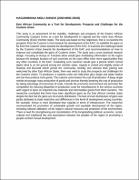| dc.description.abstract | HAGUMIMANA MOLI ANNICK (2008-M092-20048)
East African Community as a Tool for Development; Prospects and Challenges for the Customs Union
This study is an assessment of the viability, challenges and prospects of the Eastern African Community Customs Union as a tool for development in Uganda and the entire East African Community (EAC) member states. The study was based on four objectives, that is, to examine the prospects from the Customs Union towards the development of the EAC; to establish the gains so far from the Customs Union towards the development of the EAC; to examine the challenges faced by the Customs Union towards the development of the EAC and recommendations on how to improve and consolidate the gains of Customs Union. The study was a cross sectional research design. Focusing on Kenya or Tanzania alone would give misleading information on the region because the strategic location of such countries on the coast offers them more opportunities than any other countries in the EAC. Evaluating such countries would give a picture which cannot depict what is on the ground among the member states. Uganda is central and slightly ahead of Rwanda and Burundi which joined the community recently and whereas their joining was welcomed by other East African States, there was need to study the prospects and challenges for the Customs Union. To producers, a customs union can help them get a larger and wider market and can thus produce more goods. The customs union lowers the cost of production: A large single market encourages mass production of goods and services thereby lowering the cost of production by taking advantage of economies of scale. It levels the economic environment and promotes fair competition by reducing disparities in production costs for manufacturers in the various countries with regard to taxes on imported raw materials and intermediate goods from third countries. The researcher concluded that there have been significant gains by the East African member states despite the fact that the gains are not evenly distributed. The lack of even distribution of gains was partly attributed to trade restriction and differences in the level of development among countries, for example, Kenya is more developed than Uganda in terms if infrastructure. The researcher recommended the promotion of sustainable growth and equitable development of the region, including rational utilisation of the region's natural resources and protection of the environment. There is need for strengthening and consolidation of the longstanding political, economic, social, cultural and traditional ties and associations between the peoples of the region in promoting a people-centred mutual development.
Keywords: East African Community, Economic Development | en_US |


